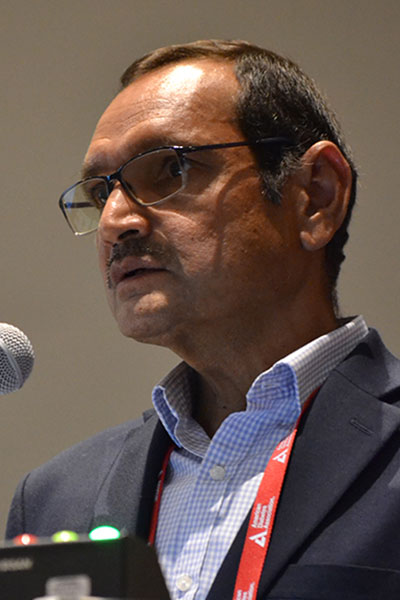Experts at the symposium, Standards of Care in Diabetes 2025 Updates, at the 85th Scientific Sessions highlighted new and updated recommendations released by the American Diabetes Association® (ADA), the Standards of Care in Diabetes—2025, the gold standard in evidence-based guidelines for diagnosing and managing diabetes and prediabetes.
Pharmacological and technological advances—such as glucose-lowering pharmacotherapy and continuous glucose monitoring (CGM)—drive many of the changes. But the 385-page document also refines key terms and clarifies general best-practice goals for essential areas of care.

Glucose-Lowering Pharmacotherapy
Significant updates came in areas of glucose-lowering therapy in diabetes, affected by the growing use of glucagon-like peptide-1 receptor agonist (GLP-1 RA) drugs, as well as innovations such as inhaled insulin and insulin patches.
Rozalina G. McCoy, MD, MS, Associate Professor and Director of Precision Medicine and Population Health, University of Maryland School of Medicine, said the guidelines for glucose-lowering therapies reflected a unifying theme: “We need to manage hyperglycemia, but we also need to prevent complications—and the two need to be addressed at the same time.”
Dr. McCoy noted that the section provided specific information on insulin adjustment in tandem with automated insulin delivery (AID) systems for use by people with type 1 diabetes, guidelines for prioritizing glucose-lowering treatment plans that avoid complications for those with type 2 diabetes, treatment of hyperglycemia for those of childbearing potential, and more.
The section also advises on what patients and clinicians should do when prescribed U.S. Food and Drug (FDA)-approved medications are not available, with a clear warning to avoid unapproved compounded products.

Diabetes Technology
Technological advancements greatly influenced updates for the prescription and use of devices in the management and care of diabetes, with particular emphasis on CGM devices.
“The choice of CGM device should be made based on the individual’s circumstances, preferences, and needs,” said Grazia Aleppo, MD, Professor of Medicine, Feinberg School of Medicine, Northwestern University. “People with diabetes should use CGMs—it’s as simple as that.”
Dr. Aleppo also pointed to updates on the use of AID systems and best-practice approaches to working with those who choose to use closed-loop, open-source devices.

Older Adults
Naushira Pandya, MD, CMD, Professor and Chair, Department of Geriatrics, Nova Southeastern University, said the 2025 section on older adults recommends CGM for older adults with type 1 diabetes as well as those with type 2 diabetes on insulin therapy for reducing hypoglycemia, for which this population has a greater risk.
The practice guidelines also recognize and respect the continuum of older adult health, based on the type of diabetes and the patient’s personal preferences.
“What matters most should come first—what the individual and the care partners want, what they are capable of doing, and what they will accept,” Dr. Pandya said.
Pregnancy

Sarit Polsky, MD, MPH, Director of the Pregnancy and Women’s Health Clinic, Barbara Davis Center for Diabetes, University of Colorado, said updates on CGM use also appear in the section on the management of diabetes in pregnancy.
But one of the biggest changes is the structural reformatting to include all types of diabetes that might be encountered during pregnancy. For example, the changed recommendation for folic acid dosage (from 400 mcg per day to a range of 400–800 mcg per day) is listed for people with diabetes, as well as for those with prediabetes or who are at risk of gestational diabetes.
Dr. Polsky noted that some new recommendations remained specific for sub-groups. The guidelines recommend AID systems with pregnancy-specific glucose targets for individuals with type 1 diabetes.

Population Health
The updated guidelines for population health also ensure that all diabetes types are included in recommendations.
“When we talk about our ideas, we often think about people who already have diabetes, but one of the adjustments that was made was to include people who are at risk of diabetes,” said Justin Echouffo Tcheugui, MD, PhD, Associate Professor, John Hopkins University.
Dr. Tcheugui noted this approach guided some of the updates in the section’s focus on social determinants of health and the “importance of engaging an interprofessional team approach to person-centered care for people with diabetes across the lifespan.”
Inpatient and DKA

Rajesh K. Garg, MD, Professor of Medicine, David Geffen School of Medicine, Harbor–UCLA Medical Center, noted that the guidelines for patients with diabetes in hospital settings consider the preoperative, postoperative, and outpatient stages of glycemia management.
This means the updated recommendations include institutional steps upon entry, such as testing A1C of all admitted patients (unless they have a test from the past three months), as well as upon release, such as deferring to individualized plans in whether to resume administration of GLP-1 or GIP/GLP-1 RAs in postoperative settings.
Dr. Garg said the guidelines clarify key terms, such as resetting the definition of hyperglycemia to a history of diabetes regardless of glucose levels or plasma glucose ≥200 mg/dL, and address basic—but critical—practices, such as ensuring that all patients with diabetes are sent home with needles or other essential equipment.
Improving Health Outcomes

Kathaleen Briggs Early, PhD, RDN, CDCES, Professor of Nutrition, Pacific Northwest University of Health Sciences, highlighted an emphasis on diabetes self-management education and support (DSMES) in her overview of the changes to the health outcomes section.
Noting that some patients with diabetes receive educational support upon diagnosis, but never afterward, Dr. Early emphasized the importance of support teams continuing to provide information, such as guideline updates on recommending water over nutritive and nonnutritive beverages for people with diabetes or prediabetes.
Dr. Early also pointed to the importance of understanding and respecting the distinctions between religious-fasting and intermittent fasting that are outlined in the guidelines.
On-demand access to recorded presentations from the 85th Scientific Session will be available to registered participants following the conclusion of the meeting in Chicago, from June 25–August 25.

Watch the Scientific Sessions On-Demand after the Meeting
Extend your learning on the latest advances in diabetes research, prevention, and care after the 85th Scientific Sessions conclude. From June 25–August 25, registered participants will have on-demand access to presentations recorded in Chicago via the meeting website.

